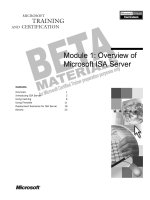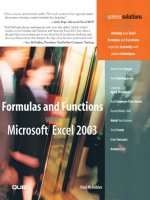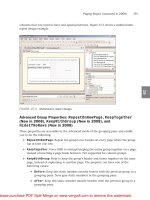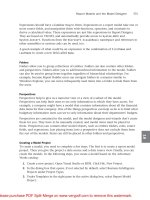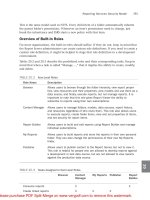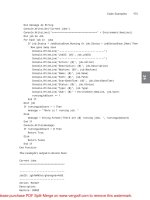Tài liệu Wiley - Data Mining with Microsoft SQL Server 2008 (2009)01 pdf
Bạn đang xem bản rút gọn của tài liệu. Xem và tải ngay bản đầy đủ của tài liệu tại đây (655.99 KB, 40 trang )
Maclennan ffirs.tex V3 - 10/04/2008 3:27am Page ii
Maclennan ffirs.tex V3 - 10/04/2008 3:27am Page i
Data Mining with
Microsoft
SQL Server
2008
Maclennan ffirs.tex V3 - 10/04/2008 3:27am Page ii
Maclennan ffirs.tex V3 - 10/04/2008 3:27am Page iii
Data Mining with
Microsoft
SQL Server
2008
Jamie MacLennan
ZhaoHui Tang
Bogdan Crivat
Wiley Publishing, Inc.
Maclennan ffirs.tex V3 - 10/04/2008 3:27am Page iv
Data Mining with Microsoft
SQL Server
2008
Published by
Wiley Publishing, Inc.
10475 Crosspoint Boulevard
Indianapolis, IN 46256
www.wiley.com
Copyright 2009 by Wiley Publishing, Inc., Indianapolis, Indiana
Published by Wiley Publishing, Inc., Indianapolis, Indiana
Published simultaneously in Canada
ISBN: 978-0-470-27774-4
Manufactured in the United States of America
10987654321
No part of this publication may be reproduced, stored in a retrieval system or transmitted in any form or by any
means, electronic, mechanical, photocopying, recording, scanning or otherwise, except as permitted under Sections
107 or 108 of the 1976 United States Copyright Act, without either the prior written permission of the Publisher, or
authorization through payment of the appropriate per-copy fee to the Copyright Clearance Center, 222 Rosewood
Drive, Danvers, MA 01923, (978) 750-8400, fax (978) 646-8600. Requests to the Publisher for permission should be
addressed to the Legal Department, Wiley Publishing, Inc., 10475 Crosspoint Blvd., Indianapolis, IN 46256, (317)
572-3447, fax (317) 572-4355, or online at www.wiley.com/go/permissions.
Limit of Liability/Disclaimer of Warranty: The publisher and the author make no representations or warranties with
respect to the accuracy or completeness of the contents of this work and specifically disclaim all warranties, including
without limitation warranties of fitness for a particular purpose. No warranty may be created or extended by sales or
promotional materials. The advice and strategies contained herein may not be suitable for every situation. This work
is sold with the understanding that the publisher is not engaged in rendering legal, accounting, or other professional
services. If professional assistance is required, the services of a competent professional person should be sought.
Neither the publisher nor the author shall be liable for damages arising herefrom. The fact that an organization or
Web site is referred to in this work as a citation and/or a potential source of further information does not mean that
the author or the publisher endorses the information the organization or Web site may provide or recommendations
it may make. Further, readers should be aware that Internet Web sites listed in this work may have changed or
disappeared between when this work was written and when it is read.
For general information on our other products and services please contact our Customer Care Department within the
U.S. at (800) 762-2974, outside the United States at (317) 572-3993, or fax (317) 572-4002.
Library of Congress Cataloging-in-Publication Data
MacLennan, Jamie.
Data mining with Microsoft SQL server 2008 / Jamie MacLennan, Bogdan Crivat, ZhaoHui Tang.
p. cm.
Includes index.
ISBN 978-0-470-27774-4 (paper/website)
1. SQL server. 2. Data mining. I. Crivat, Bogdan. II. Tang, Zhaohui. III. Title.
QA76.9.D343M335 2008
005.75
85 — dc22
2008035467
Trademarks: Wileyand the Wiley logo are trademarks or registered trademarks of John Wiley & Sons, Inc. and/or its
affiliates, in the United States and other countries, and may not be used without written permission. Microsoft and
SQL Server are registered trademarks of Microsoft Corporation in the United States and/or other countries. All other
trademarks are the property of their respective owners. Wiley Publishing, Inc. is not associated with any product or
vendor mentioned in this book.
Wiley also publishes its books in a variety of electronic formats. Some content that appears in print may not be
available in electronic books.
Maclennan ffirs.tex V3 - 10/04/2008 3:27am Page v
To Logan, because he needs it the most.
— Jamie MacLennan
This book is for Cosmin, with great hope that he will
someday find math (and data mining) to be
fun and interesting.
— Bogdan Crivat
Maclennan ffirs.tex V3 - 10/04/2008 3:27am Page vi
Maclennan f01.tex V2 - 10/04/2008 3:30am Page vii
About the Authors
Jamie MacLennan is the principal development manager of SQL Server Analy-
sis Services at Microsoft. In addition to being responsible for the development
and delivery of the Data Mining and OLAP technologies for SQL Server,
MacLennan is a proud husband and father of four. He has more than 25 patents
and patents pending for his work on SQL Server Data Mining. MacLennan
has written extensively on the data mining technology in SQL Server, includ-
ing many articles in MSDN Magazine, SQL Server Magazine, and postings on
SQLServerDataMining.com and his blog at />This is his second edition of Data Mining with SQL Server. MacLennan has been
a featured and invited speaker at conferences worldwide, including Microsoft
TechEd, Microsoft TechEd Europe, SQL PASS, the Knowledge Discovery and
Data Mining (KDD) conference, the Americas Conference on Information
Systems (AMCIS), and the Data Mining Cup conference.
ZhaoHui Tang is a group program manager at Microsoft adCenter Labs,
where he manages a number of research projects related to paid search and
content ads. He is the inventor of Microsoft Keyword Services Platform. Prior
to adCenter, he spent six years as a lead program manager in the SQL Server
Business Intelligence (BI) group, mainly focusing on data mining develop-
ment. He has written numerous articles for both academic and industrial
publications, such as The VLDB Journal and SQL Server Magazine.Heisa
frequent speaker at business intelligence conferences. He was also a co-author
of the previous edition of this book, Data Mining with SQL Server 2005.
Bogdan Crivat is a senior software design engineer in SQL Server Analy-
sis Services at Microsoft, working primarily on the Data Mining platform.
vii
Maclennan f01.tex V2 - 10/04/2008 3:30am Page viii
viii About the Authors
Crivat has written various articles on data mining for MSDN Magazine
and Access/VB/SQL Advisor Magazine,aswellasnumerouspostingsonthe
SQLServerDataMining.com website and on the MSDN Forums. He presented
at various Microsoft and data mining professional conferences. Crivat also
blogs about SQL Server Data Mining at
www.bogdancrivat.net/dm.
Maclennan f02.tex V2 - 10/04/2008 3:31am Page ix
Credits
Executive Editor
Robert Elliott
Development Editor
Kevin Shafer
Technical Editors
Raman Iyer; Shuvro Mitra
Production Editor
Dassi Zeidel
Copy Editor
Kathryn Duggan
Editorial Manager
Mary Beth Wakefield
Production Manager
Tim Tate
Vice President and Executive
Group Publisher
Richard Swadley
Vice President and Executive
Publisher
Joseph B. Wikert
Project Coordinator, Cover
Lynsey Stanford
Proofreader
Publication Services, Inc.
Indexer
Ted Laux
Cover Image
Darren Greenwood/Design Pics/
Corbis
ix
Maclennan f02.tex V2 - 10/04/2008 3:31am Page x
Maclennan f03.tex V2 - 10/04/2008 3:31am Page xi
Acknowledgments
First of all we would like to acknowledge the help from our data mining
team members and other colleagues in the Microsoft SQL Server Business
Intelligence (BI) organization. In addition to creating the best data mining
package on the planet, most of them gave up some of their free time to review
the text and sample code. Direct thanks go to Shuvro Mitra, Raman Iyer, Dana
Cristofor, Jeanine Nelson-Takaki, and Niketan Pansare for helping review our
text to ensure that it makes sense and that our samples work. Thanks also to
the rest of the data mining team, including Donald Farmer, Tatyana Yakushev,
Yimin Wu, Fernando Godinez Delgado, Gang Xiao, Liu Tang, and Bo Simmons
for building such a great product. In addition, we would like to thank the SQL
BI management of Kamal Hathi and Tom Casey for supporting data mining
in SQL Server.
SQL Server 2008 Data Mining (including the Data Mining Add-Ins) is a
product jointly developed by the SQL Server Analysis Services team and
other teams inside Microsoft. We would like to thank colleagues from Excel
— notably Rob Collie, Howie Dickerman, and Dan Battagin, whose valuable
input into the design of the Data Mining Add-Ins guaranteed their success.
Also thanks to those in the Machine Learning and Applied Statistics (MLAS)
Group, headed by Research Manager David Heckerman, who continue to
advise us on deep algorithmic issues in our product. We would like to thank
David Heckerman, Jesper Lind, Alexei Bocharov, Chris Meek, Bo Thiesson,
and Max Chickering for their contributions.
We would like to give special thanks to Kevin Shafer for his close editing
of our text, which has greatly improved the quality of this manuscript. Also
thanks to Wiley Publications acquisitions editor Bob Elliot for his support and
patience.
xi
Maclennan f03.tex V2 - 10/04/2008 3:31am Page xii
xii Acknowledgments
Special thanks from Jamie to his wife, April, who yet again supported him
through the ups and downs of authoring a book, particularly during painful
rewrites and recaptures of screen shots, while taking care of our kids and the
world around me. Elalu, honey.
Bogdan would like to thank his wife, Irinel, for supporting him, reviewing
his chapters, and some really helpful hints for capturing screen shots.
Maclennan cag.tex V2 - 10/04/2008 3:54am Page xiii
Contents at a Glance
Foreword xxix
Introduction xxxi
Chapter 1 Introduction to Data Mining in SQL Server 2008 1
Chapter 2 Applied Data Mining Using Microsoft Excel 2007 15
Chapter 3 Data Mining Concepts and DMX 83
Chapter 4 Using SQL Server Data Mining 127
Chapter 5 Implementing a Data Mining Process Using Office 2007 187
Chapter 6 Microsoft Na
¨
ıve Bayes 215
Chapter 7 Microsoft Decision Trees Algorithm 235
Chapter 8 Microsoft Time Series Algorithm 263
Chapter 9 Microsoft Clustering 291
Chapter 10 Microsoft Sequence Clustering 319
Chapter 11 Microsoft Association Rules 343
Chapter 12 Microsoft Neural Network and Logistic Regression 371
Chapter 13 Mining OLAP Cubes 399
Chapter 14 Data Mining with SQL Server Integration Services 439
Chapter 15 SQL Server Data Mining Architecture 475
Chapter 16 Programming SQL Server Data Mining 497
Chapter 17 Extending SQL Server Data Mining 541
xiii
Maclennan cag.tex V2 - 10/04/2008 3:54am Page xiv
xiv Contents at a Glance
Chapter 18 Implementing a Web Cross-Selling Application 563
Chapter 19 Conclusion and Additional Resources 581
Appendix A Data Sets 589
Appendix B Supported Functions 595
Index 607
Maclennan ftoc.tex V2 - 10/06/2008 6:07am Page xv
Contents
Foreword xxix
Introduction xxxi
Chapter 1 Introduction to Data Mining in SQL Server 2008 1
Business Problems for Data Mining 4
Data Mining Tasks 6
Classification 6
Clustering 6
Association 7
Regression 8
Forecasting 8
Sequence Analysis 9
Deviation Analysis 9
Data Mining Project Cycle 9
Business Problem Formation 10
Data Collection 10
Data Cleaning and Transformation 10
Model Building 12
Model Assessment 12
Reporting and Prediction 12
Application Integration 13
Model Management 13
Summary 13
Chapter 2 Applied Data Mining Using Microsoft Excel 2007 15
Setting Up the Table Analysis Tools 16
Configuring Analysis Services with Administrative Privileges 17
xv
Maclennan ftoc.tex V2 - 10/06/2008 6:07am Page xvi
xvi Contents
Configuring Analysis Services without Administrative
Privileges 18
What the Add-Ins Expect 19
What to Do If You Need Help 22
The Analyze Key Influencers Tool 22
The Main Influencers Report 24
The Discrimination Report 26
Summary of the Analyze Key Influencers Task 28
The Detect Categories Tool 28
Launching the Tool 29
The Categories Report 30
Categories and the Number of Rows in Each 30
Characteristics of Each Category 31
The Category Profiles Chart 32
Summary of the Detect Categories Tool 34
The Fill From Example Tool 35
Running the Tool and Interpreting the Results 36
Refining the Results 38
Summary of the Fill From Example Tool 39
The Forecasting Tool 39
Launching the Tool and Specifying Options 40
Interpreting the Results 42
Summary of the Forecast Tool 44
The Highlight Exceptions Tool 44
Using the Tool 45
More Complex Interactions 48
Limitations and Troubleshooting 50
Summary of the Highlight Exceptions Tool 51
The Scenario Analysis Tool 51
The Goal Seek Tool 53
Using Goal Seek for a Numeric Goal 56
Using Goal Seek for the Whole Table 57
The What-If Tool 58
Using What-If for the Whole Table 61
Summary of the Scenario Analysis Tool 62
The Prediction Calculator Tool 62
Running the Tool 64
The Prediction Calculator Spreadsheet 65
The Printable Calculator Spreadsheet 67
Refining the Results 68
Using the Results 73
Summary of the Prediction Calculator Tool 73
Maclennan ftoc.tex V2 - 10/06/2008 6:07am Page xvii
Contents xvii
The Shopping Basket Analysis Tool 74
Using the Tool 75
The Bundled Item Report 76
The Recommendations Report 77
Tweaking the Tool 79
Summary of the Shopping Basket Analysis Tool 81
Technical Overview of the Table Analysis Tools 81
Summary 82
Chapter 3 Data Mining Concepts and DMX 83
History of DMX 83
Why DMX? 84
The Data Mining Process 85
Key Concepts 86
Attribute 86
State 87
Case 88
Keys 89
Inputs and Outputs 91
DMX Objects 93
Mining Structure 93
Mining Model 94
DMX Query Syntax 95
Creating Mining Structures 96
Discretized Columns 97
Nested Tables 98
Partitioning into Testing and Training Sets 99
Creating Mining Models 100
Nested Tables 101
Complex Nesting Scenarios 104
Filters 107
Populating Mining Structures 108
Populating Nested Tables 110
Querying Structure Data 112
Querying Model Data 112
Prediction 115
Prediction Join 116
Prediction Query Syntax 116
Nested Source Data 117
Real-Time Prediction 118
Degenerate Predictions 119
Maclennan ftoc.tex V2 - 10/06/2008 6:07am Page xviii
xviii Contents
Prediction Functions 120
PredictNodeID 122
External and User-Defined Functions 123
Predictions on Nested Tables 123
Predicting Nested Value Columns 124
Summary 125
Chapter 4 Using SQL Server Data Mining 127
Introducing the Business Intelligence Development Studio 128
Understanding the User Interface 128
Offline Mode and Immediate Mode 130
Immediate Mode 131
Getting Started in Immediate Mode 131
Offline Mode 132
Getting Started in Offline Mode 133
Switching Project Modes 135
Creating Data Mining Objects 135
Setting Up Your Data Sources 135
Understanding Data Sources 136
Creating the MovieClick Data Source 137
Using the Data Source View 137
Creating the MovieClick Data Source View 138
Working with Named Calculations 140
Creating a Named Calculation on the Customers Table 142
Working with Named Queries 142
Creating a Named Query Based on the Customers Table 143
Organizing the DSV 144
Exploring Data 145
Creating and Editing Models 148
Structures and Models 148
Using the Data Mining Wizard 148
Creating the MovieClick Mining Structure and Model 155
Using Data Mining Designer 157
Working with the Mining Structure Editor 157
Adding the Genre Column to the Movies Nested Table 159
Working with the Mining Models Editor 160
Creating and Modifying Additional Models 163
Processing 164
Processing the MovieClick Mining Structure 165
Using Your Models 166
Understanding the Model Viewers 166
Using the Mining Accuracy Chart 167
Selecting Test Data 168
Maclennan ftoc.tex V2 - 10/06/2008 6:07am Page xix
Contents xix
Understanding the Accuracy Charts 169
Using the Profit Chart 171
Multiple Target Accuracy Charts 172
Using the Classification Matrix 173
Scatter Accuracy Charts 173
Creating a Lift Chart on MovieClick 174
Using CrossValidation 174
Using the Mining Model Prediction Builder 178
Executing a Query on the MovieClick Model 179
Creating Data Mining Reports 180
Using SQL Server Management Studio 181
Understanding the Management Studio User Interface 182
Using Server Explorer 182
Using Object Explorer 183
Using the Query Editor 184
Summary 185
Chapter 5 Implementing a Data Mining Process Using Office 2007 187
Introducing the Data Mining Client 188
Importing Data Using the Data Mining Client 189
Data Exploration and Preparation 190
Discretizing Data with the Explore Data Tool 191
Chopping Off the Long Tail 191
Consolidating Meaning 192
Eliminating Spurious Values 194
Rebalancing Data 195
Modeling 196
Task-Based Modeling 196
Introduction 198
Select Data 198
Select Columns and Options 198
Split Data 200
Finishing the Task 200
Advanced Modeling in the Data Mining Client 200
Accuracy and Validation 203
Model Usage 204
Browsing Models 204
Viewing Models with Visio 205
Querying Models 208
Query Wizard 208
Data Mining Cell Functions 211
DMPREDICT 211
DMPREDICTTABLEROW 212
Maclennan ftoc.tex V2 - 10/06/2008 6:07am Page xx
xx Contents
DMCONTENTQUERY 212
Model Management 213
Trace 213
Summary 213
Chapter 6 Microsoft Na
¨
ıve Bayes 215
Introducing the Na
¨
ıve Bayes Algorithm 216
Using the Na
¨
ıve Bayes Algorithm 216
Creating a Predictive Model 217
Data Exploration 219
Analysis of Key Influencers 219
Document Classification 220
DMX 222
Drill-through 222
Understanding Na
¨
ıve Bayes Content 223
Exploring a Na
¨
ıve Bayes Model 225
Dependency Network 225
Attribute Profiles 226
Attribute Characteristics 227
Attribute Discrimination 228
Understanding Na
¨
ıve Bayes Principles 229
Limitations of the Na
¨
ıve Bayes Algorithm 231
Na
¨
ıve Bayes Parameters 233
MAXIMUM
−
INPUT
−
ATTRIBUTES 233
MAXIMUM
−
OUTPUT
−
ATTRIBUTES 233
MAXIMUM
−
STATES 233
MINIMUM
−
DEPENDENCY
−
PROBABILITY 234
Summary 234
Chapter 7 Microsoft Decision Trees Algorithm 235
Introducing Decision Trees 236
Using Decision Trees 237
Creating a Decision Tree Model 237
DMX Queries 237
Classification Model 237
Regression Model 239
Association 241
Model Content 244
Interpreting the Model 244
Decision Tree Principles 248
Basic Concepts of Tree Growth 248
Working with Many States in an Attribute 251
Avoiding Overtraining 252
Incorporating Prior Knowledge 252
Feature Selection 253
Maclennan ftoc.tex V2 - 10/06/2008 6:07am Page xxi
Contents xxi
Using Continuous Inputs 253
Regression 254
Association Analysis with Microsoft Decision Trees 255
Parameters 256
COMPLEXITY
−
PENALTY 257
MINIMUM
−
SUPPORT 257
SCORE
−
METHOD 257
SPLIT
−
METHOD 258
MAXIMUM
−
INPUT
−
ATTRIBUTES 258
MAXIMUM
−
OUTPUT
−
ATTRIBUTES 258
FORCE
−
REGRESSOR 258
Stored Procedures 259
Summary 260
Chapter 8 Microsoft Time Series Algorithm 263
Overview 264
Usage 265
Time Series Scenarios 267
Performing a Simple Forecast 267
Predicting Interdependent Series 268
Understanding Your Time Series 268
What-If Scenarios 269
Predicting New Series 269
DMX 270
Model Creation 270
Model Processing 272
Forecasting 274
Returning Supplemental Statistics 275
Changing the Future — Executing a What-If Forecast 276
Forecasting with Little Data — Applying Models to New
Data 277
Drill-Through 280
Principles of Time Series 280
Autoregression 281
Periodicity 281
Autoregression Trees 282
Prediction 284
Parameters 285
MISSING
−
VALUE
−
SUBSTITUTION 285
PERIODICITY
−
HINT 286
AUTO
−
DETECT
−
PERIODICITY 286
MINIMUM and MAXIMUM
−
SERIES
−
VALUE 286
FORECAST
−
METHOD 286
PREDICTION
−
SMOOTHING 287
Maclennan ftoc.tex V2 - 10/06/2008 6:07am Page xxii
xxii Contents
INSTABILITY
−
SENSITIVITY 287
HISTORIC
−
MODEL
−
COUNT and
HISTORIC
−
MODEL
−
GAP 287
COMPLEXITY
−
PENALTY and MINIMUM
−
SUPPORT 288
Model Content 289
Summary 289
Chapter 9 Microsoft Clustering 291
Overview 292
Usage of Clustering 294
Performing a Clustering 295
Clustering as an Analytical Step 297
Anomaly Detection Using Clustering 297
DMX 299
Model Creation 300
Drill-Through 301
Cluster 301
ClusterProbability 301
PredictHistogram 302
PredictCaseLikelihood 302
Model Content 303
Understanding Your Cluster Models 304
Get a High-Level Overview 305
Pick a Cluster and Determine how It Is Different from the
General Population 307
Determine how the Cluster Is Different from Nearby
Clusters 308
Verify that Your Assertions Are True 309
Label the Cluster 309
Principles of Clustering 309
Hard Clustering versus Soft Clustering 311
Discrete Clustering 312
Scalable Clustering 313
Clustering Prediction 314
Parameters 314
CLUSTERING
−
METHOD 314
CLUSTER
−
COUNT 315
MINIMUM
−
CLUSTER
−
CASES 315
MODELLING
−
CARDINALITY 316
STOPPING
−
TOLERANCE 316
SAMPLE
−
SIZE 316
CLUSTER
−
SEED 317
MAXIMUM
−
INPUT
−
ATTRIBUTES 317
MAXIMUM
−
STATES 318
Maclennan ftoc.tex V2 - 10/06/2008 6:07am Page xxiii
Contents xxiii
Summary 318
Chapter 10 Microsoft Sequence Clustering 319
Introducing the Microsoft Sequence Clustering Algorithm 320
Using the Microsoft Sequence Clustering Algorithm 320
Creating a Sequence Clustering Model 321
DMX Queries 322
Executing Cluster Predictions 323
Executing Sequence Predictions 323
Extracting the Probability for the Sequence Predictions 325
Using the Histogram of the Sequence Predictions 326
Detecting Unusual Sequence Patterns 329
Interpreting the Model 329
Cluster Diagram 330
Cluster Profiles 331
Cluster Characteristics 331
Cluster Discrimination 333
State Transitions 333
Microsoft Sequence Clustering Algorithm Principles 334
Understanding a Markov Chain 334
Order of a Markov Chain 335
State Transition Matrix 336
Clustering with a Markov Chain 337
Cluster Decomposition 339
Model Content 339
Algorithm Parameters 340
CLUSTER
−
COUNT 340
MINIMUM
−
SUPPORT 340
MAXIMUM
−
STATES 341
MAXIMUM
−
SEQUENCE
−
STATES 341
Summary 341
Chapter 11 Microsoft Association Rules 343
Introducing Microsoft Association Rules 344
Using the Association Rules Algorithm 344
Data Exploration Models 345
A Simple Recommendation Engine 346
Advanced Cross-Sales Analysis 349
DMX 351
Model Content 355
Interpreting the Model 357
Association Algorithm Principles 359
Understanding Basic Association Algorithm Terms and
Concepts 359
Itemset 360




